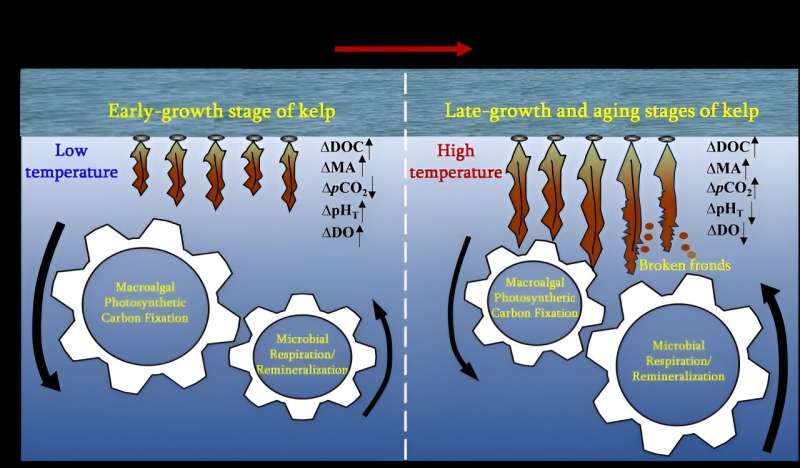This article has been reviewed according to Science X's editorial process and policies. Editors have highlighted the following attributes while ensuring the content's credibility:
fact-checked
trusted source
proofread
Seaweed farming environments do not always function as CO₂ sinks, study finds

Under climate scenarios, seaweed farming is now used globally as a promising approach for achieving carbon neutrality. Seaweed farming contributes substantial amounts of organic carbon to the ocean, part of which can be locked for a long time in the ocean and function as ocean carbon sequestration, and the other part can be converted to inorganic carbon through microbial mineralization and aerobic respiration, affecting the seawater carbonate system and carbon dioxide (CO2) sink/source effects (note that CO2 sink ≠ carbon sequestration).
It is generally believed that seaweed farming will cause the seawater to become a sink for CO2 due to carbon fixation by macroalgal photosynthesis. However, little attention has been paid to the fact that seaweed farming environment can sometimes become a source of CO2 rather than a sink.
Researchers from the Qingdao Institute of Bioenergy and Bioprocess Technology of the Chinese Academy of Sciences have revealed the dynamic CO2 sink/source and environmental effects of seaweed farming at different growth stages of kelp under microbial regulation. Their findings were published in Agriculture, Ecosystems & Environment.
The researchers carried out in-situ mesocosm cultivation experiments and eight field studies of different kelp growth stages in an intensive farming area in China. They found that the seaweed farming environment acted as a CO2 sink during the fast-growth stage of kelp (from January to April), but became a source of CO2 during the aging stage of kelp (from late May to July). At the same time, seawater pH and dissolved oxygen that were increasing in the early months started decreasing in May to July.
Late-stage kelps can rapidly cause seawater acidification and deoxygenation, turning the surrounding seawater environment into a CO2 source. The release of dissolved organic carbon by late-stage kelps increased significantly, supporting the increase in microbial abundance and respiration, which was manifested by the remarkable decrease in seawater dissolved oxygen, ultimately leading to CO2 release exceeding photosynthetic CO2 absorption.
This study is significant for the comprehensive evaluation of the effects of macroalgal carbon sequestration and the rational management of seaweed farming.
More information: Tianqi Xiong et al, Seaweed farming environments do not always function as CO2 sink under synergistic influence of macroalgae and microorganisms, Agriculture, Ecosystems & Environment (2023). DOI: 10.1016/j.agee.2023.108824
Provided by Chinese Academy of Sciences





















